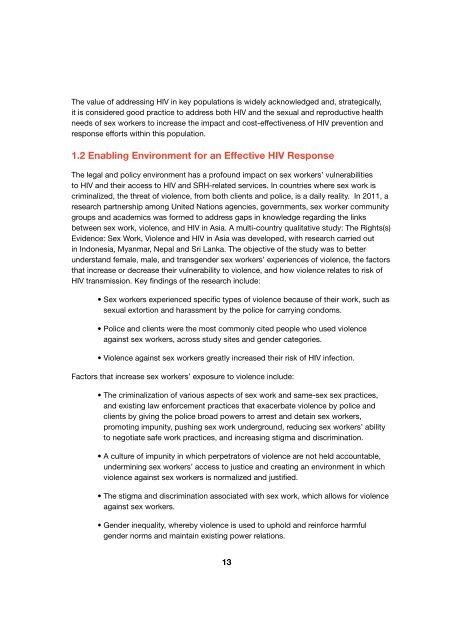THE CONDOM QUANDARY
1eRssObgU
1eRssObgU
You also want an ePaper? Increase the reach of your titles
YUMPU automatically turns print PDFs into web optimized ePapers that Google loves.
The value of addressing HIV in key populations is widely acknowledged and, strategically,<br />
it is considered good practice to address both HIV and the sexual and reproductive health<br />
needs of sex workers to increase the impact and cost-effectiveness of HIV prevention and<br />
response efforts within this population.<br />
1.2 Enabling Environment for an Effective HIV Response<br />
The legal and policy environment has a profound impact on sex workers’ vulnerabilities<br />
to HIV and their access to HIV and SRH-related services. In countries where sex work is<br />
criminalized, the threat of violence, from both clients and police, is a daily reality. In 2011, a<br />
research partnership among United Nations agencies, governments, sex worker community<br />
groups and academics was formed to address gaps in knowledge regarding the links<br />
between sex work, violence, and HIV in Asia. A multi-country qualitative study: The Rights(s)<br />
Evidence: Sex Work, Violence and HIV in Asia was developed, with research carried out<br />
in Indonesia, Myanmar, Nepal and Sri Lanka. The objective of the study was to better<br />
understand female, male, and transgender sex workers’ experiences of violence, the factors<br />
that increase or decrease their vulnerability to violence, and how violence relates to risk of<br />
HIV transmission. Key findings of the research include:<br />
• Sex workers experienced specific types of violence because of their work, such as<br />
sexual extortion and harassment by the police for carrying condoms.<br />
• Police and clients were the most commonly cited people who used violence<br />
against sex workers, across study sites and gender categories.<br />
• Violence against sex workers greatly increased their risk of HIV infection.<br />
Factors that increase sex workers’ exposure to violence include:<br />
• The criminalization of various aspects of sex work and same-sex sex practices,<br />
and existing law enforcement practices that exacerbate violence by police and<br />
clients by giving the police broad powers to arrest and detain sex workers,<br />
promoting impunity, pushing sex work underground, reducing sex workers’ ability<br />
to negotiate safe work practices, and increasing stigma and discrimination.<br />
• A culture of impunity in which perpetrators of violence are not held accountable,<br />
undermining sex workers’ access to justice and creating an environment in which<br />
violence against sex workers is normalized and justified.<br />
• The stigma and discrimination associated with sex work, which allows for violence<br />
against sex workers.<br />
• Gender inequality, whereby violence is used to uphold and reinforce harmful<br />
gender norms and maintain existing power relations.<br />
13


